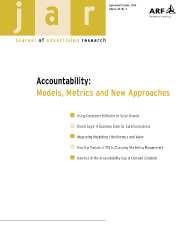Crossref Citations
This article has been cited by the following publications. This list is generated based on data provided by
Crossref.
Gelbrich, Katja
and
Wünschmann, Stefan
2006.
Kundenwert.
p.
583.
Algesheimer, RenÉ
and
Wangenheim, Florian v.
2006.
A Network Based Approach to Customer Equity Management.
Journal of Relationship Marketing,
Vol. 5,
Issue. 1,
p.
39.
Haenlein, Michael
Kaplan, Andreas M.
and
Schoder, Detlef
2006.
Valuing the Real Option of Abandoning Unprofitable Customers when Calculating Customer Lifetime Value.
Journal of Marketing,
Vol. 70,
Issue. 3,
p.
5.
Haenlein, Michael
Kaplan, Andreas M.
and
Schoder, Detlef
2006.
Valuing the Real Option of Abandoning Unprofitable Customers when Calculating Customer Lifetime Value.
Journal of Marketing,
Vol. 70,
Issue. 3,
p.
5.
Vilpponen, Antti
Winter, Susanna
and
Sundqvist, Sanna
2006.
Electronic Word-of-Mouth in Online Environments.
Journal of Interactive Advertising,
Vol. 6,
Issue. 2,
p.
8.
Zeithaml, Valarie A.
Bolton, Ruth N.
Deighton, John
Keiningham, Timothy L.
Lemon, Katherine N.
and
Petersen, J. Andrew
2006.
Forward-Looking Focus.
Journal of Service Research,
Vol. 9,
Issue. 2,
p.
168.
Bolton, Ruth N.
and
Tarasi, Crina O.
2007.
Review of Marketing Research.
Vol. 3,
Issue. ,
p.
3.
Dong, Weimin
Swain, Scott D.
and
Berger, Paul D.
2007.
The role of channel quality in customer equity management.
Journal of Business Research,
Vol. 60,
Issue. 12,
p.
1243.
Hung, Kineta H.
and
Li, Stella Yiyan
2007.
The Influence of eWOM on Virtual Consumer Communities: Social Capital, Consumer Learning, and Behavioral Outcomes.
Journal of Advertising Research,
Vol. 47,
Issue. 4,
p.
485.
Keiningham, Timothy L.
Cooil, Bruce
Andreassen, Tor Wallin
and
Aksoy, Lerzan
2007.
A Longitudinal Examination of Net Promoter and Firm Revenue Growth.
Journal of Marketing,
Vol. 71,
Issue. 3,
p.
39.
Büschken, Joachim
2007.
Determinants of Brand Advertising Efficiency: Evidence from the German Car Market.
Journal of Advertising,
Vol. 36,
Issue. 3,
p.
51.
v. Wangenheim, Florian
and
Bayón, Tomás
2007.
The chain from customer satisfaction via word-of-mouth referrals to new customer acquisition.
Journal of the Academy of Marketing Science,
Vol. 35,
Issue. 2,
p.
233.
Mazzarol, Tim
Sweeney, Jillian C.
and
Soutar, Geoffrey N.
2007.
Conceptualizing word‐of‐mouth activity, triggers and conditions: an exploratory study.
European Journal of Marketing,
Vol. 41,
Issue. 11/12,
p.
1475.
Keiningham, Timothy L
Cooil, Bruce
Andreassen, Tor Wallin
and
Aksoy, Lerzan
2007.
A Longitudinal Examination of Net Promoter and Firm Revenue Growth.
Journal of Marketing,
Vol. 71,
Issue. 3,
p.
39.
Sweeney, Jillian C.
Soutar, Geoffrey N.
and
Mazzarol, Tim
2008.
Factors influencing word of mouth effectiveness: receiver perspectives.
European Journal of Marketing,
Vol. 42,
Issue. 3/4,
p.
344.
Drengner, Jan
Gaus, Hansjoerg
and
Jahn, Steffen
2008.
Does Flow Influence the Brand Image in Event Marketing?.
Journal of Advertising Research,
Vol. 48,
Issue. 1,
p.
138.
Blömeke, Eva
Braun, Alexander
and
Clement, Michel
2008.
Web 2.0.
p.
289.
Simpson, Penny M.
and
Siguaw, Judy A.
2008.
Destination Word of Mouth.
Journal of Travel Research,
Vol. 47,
Issue. 2,
p.
167.
Lin, Tom M. Y.
and
Liao, Chun-Wei
2008.
Knowledge Dissemination of Word-of-Mouth Research: Citation Analysis and Social Network Analysis.
Libri,
Vol. 58,
Issue. 4,
Goldenberg, Jacob
Lowengart, Oded
and
Shapira, Daniel
2009.
Integrating the Social Network to Diffusion Model and Evaluation of the Value of Hubs in the Adoption Process.
SSRN Electronic Journal,

